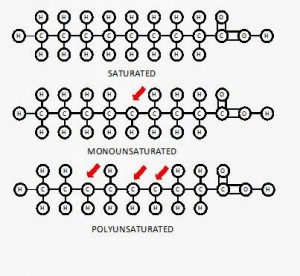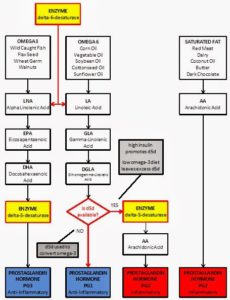By Peter Wright, NTP
This post is part of a six part series on fat. Please be sure to check out the other posts in this series. Click to return to Part 1 with links to the other posts in the series.
Part 2: Heart Disease is NOT the Result of Fat Consumption
Part 3: What are SFA, MUFA, PUFA, and Omega 3 & 6 Fats?
Part 4: How to Avoid Unhealthy BAD Fats
Part 5: How to Balance Your Fat Intake for Optimum Health
Part 6: The Buyer’s Guide for Fat including Cooking Safely with Fats
 |
| Fat Molecules |
There are many different types of dietary fats. A basic understanding of their characteristics will allow you to make better food choices and optimize your health. Fats are defined by their chemical structure. To understand fats requires looking at how they are constructed.
Fats are made of molecules called fatty acids classified as saturated(SFA), monounsaturated(MUFA) or polyunsaturated(PUFA). Saturated fats have two hydrogen atoms bonded to every carbon atom. The carbon atoms are said to be “fully saturated” with hydrogen atoms, hence the name saturated fat. In unsaturated fats one or more of the hydrogen bonds is missing. In a monounsaturated fat, mono meaning one, one of the hydrogen bonds is missing. In a polyunsaturated fat, poly meaning many, two or more of the hydrogen bonds is missing. In the diagrams the red arrows indicate the missing bonds.
It’s a misconception to call specific foods saturated fats. All natural foods contain a combination of saturated, monounsaturated or polyunsaturated fats. For example beef fat is 54% unsaturated, lard is 60% unsaturated, and chicken fat is 70% unsaturated. These products would more accurately be called unsaturated fats, rather than saturated! These three categories of fat are used differently within your body and all three have important purposes discussed in Part 1 of the series.
There are many different types of saturated, monounsaturated, and polyunsaturated fats. These terms should be thought of as representing families of fatty acids. Within the polyunsaturated family there are some very important families of fats called omega-3 and omega-6 fatty acids. You may have heard the term “essential fatty acids” or EFA’s before. The omega-3 , Alpha-linolenic Acid (LNA), and the omega-6, Linoleic Acid (LA), are considered essential.
“Essential” means your body cannot produce these fatty acids by itself and must get them from the food you eat. With sufficient LNA and LA your body can manufacture all the other omega-3 and omega-6 fatty acids it needs. Omega-3 and omega-6 fatty acids are constructed differently. The 3 or 6 indicate the relative position of the first missing hydrogen bond.
Not everyone is able to make the conversion to EPA and DHA from LNA. If your ethnic heritage includes ancestors who provided much of their diet from coastal fish your genetic profile may require you to supplement your diet with fish oils to provide EPA and DHA directly. Fish oil bypasses the LNA conversion and supplies EPA and DHA directly.
Both omega-3 and omega-6 are used to build hormones, called prostaglandins, which control inflammation within the body. Some classes of prostaglandins promote inflammation and some classes of prostaglandins reduce inflammation. We need both pro-inflammatory and anti-inflammatory prostaglandins to properly promote healing. Inflammation is an essential process in the normal healing process, but it must not go on forever.
The ratio of omega-3 to omega-6 in the diet is very important. The typical American diet contains too many omega-6 fatty acids and not enough omega-3 fatty acids. This can tip the scale toward inflammatory disease.
 |
| Omega 3 and Omega 6 Conversion |
The omega-3, LNA, and the omega-6, LA, compete for the enzyme delta-6-desaturase for their conversions. An excess of Omega-6 in the diet will leave little or no delta-6-desaturase for Omega-3 conversion.
In addition, a different enzyme called delta-5-desaturase can be used either in Omega-3 conversion or Omega-6 conversion. If Omega-3’s are available in the diet, they will utilize the delta-5-desaturase for anti-inflammatory prostaglandins formation. If Omega-3’s are not available the delta-5-desaturase redirects the conversion of omega-6’s to arachidonic acid and inflammatory prostaglandins, rather than it’s normal conversion to anti-inflammatory prostaglandins. High insulin levels can also promote production of delta-5-desaturase and increase production of inflammatory prostaglandins. This explains how a diet low in omega-3’s and high in omega-6’s (the typical American diet) results in inflammatory disease.
Before we leave the topic I want to explain another term used in identifying fats, triglyceride. When three fatty acids are joined by a glycerol molecule, they are called a triglyceride, tri meaning three. Triglycerides can be saturated, monounsaturated, or polyunsaturated. Triglycerides are further classified by the length of their carbon chains. Long chain triglycerides (LCT) have 13 to 22 carbons, medium chain triglycerides (MCT) have 6 to 12 carbons, and short chain triglycerides (SCT) have 3 to 5 carbons. About 97% of the fats we consume are LCT’s. The remaining 3% are MCT’s, as SCT’s are very rare. These different triglycerides are metabolized differently by your body.
In Part 5 of the series we’ll discuss how to balance these fats in your diet but, before we get there, we need to discuss which fats to avoid in Part 4 of this series. The food industry has found ways to increase profits by processing and altering natural fats and oils in ways that make them very dangerous to your health. The FDA has given their stamp of approval to these toxic substances. The protection of your health is dependent upon you taking personal responsibility to become knowledgeable about what you’re eating.
Latest posts by Peter Wright, NTP, CGP (see all)
- Dehydrated Broth – Making It Easy to Drink Broth Every Day! - March 11, 2017
- Lose 10 lbs DURING the Holidays - November 19, 2016
- Finding Good Oils - February 7, 2016


No comments yet.